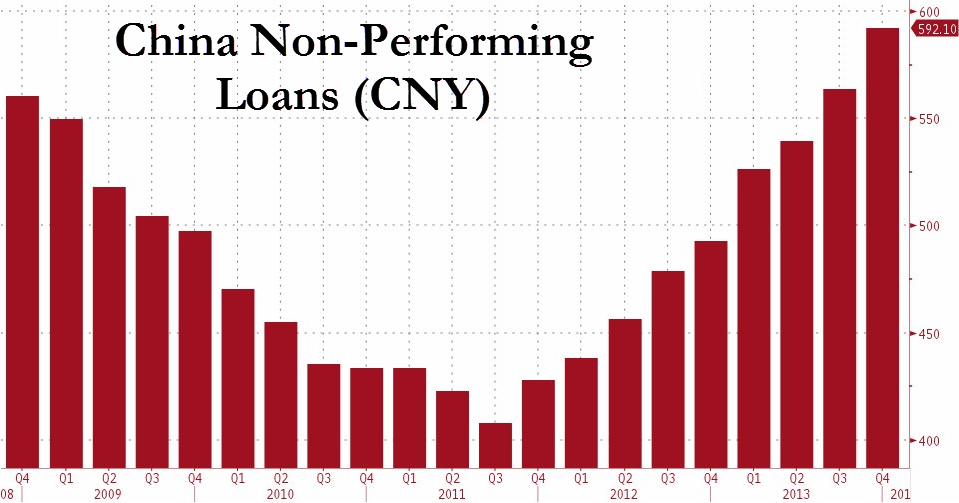Cross-posted from The Diplomat (my former baby):

China is coming under close scrutiny these days, as the leadership scurries to find new sources of economic growth and control its debt. Some analysts have reassured China watchers that the Chinese government can simply write off its bad debt, at least within the major banks, and pass it on to the asset management companies that handle that resale of distressed debt (or have it later purchased by the Ministry of Finance). Others have warned that some of the debt is serious, such as that incurred by local government financing vehicles, and are dubious about the sustainability of these entities. To worry or unwind? How much debt can China really absorb?
The first step in answering this would be to examine what types of debt has gone bad in China and what is likely to continue to sour, as well as how these products have been dealt with. There are three general categories of bad debt that have been bailed out in recent years (there is other bad debt that has not been bailed out): bank loans, trust loans, and loans from smaller sectors such as informal finance and credit guarantee companies. Problems with trust loans and loans from smaller sectors have generally been handled by local governments, while bank loans have been bailed out via asset management companies funded through the Ministry of Finance. Trust loans bailed out by local governments have involved sums in the low billions of RMB, while non-performing bank loans amounted to about 1.5 trillion RMB between 2011 and 2013.
The second step is to consider how well the central and local governments can cope with a potential increase in bad debt. While local governments are overly indebted, as revealed by a recent report by the National Audit Office, and have experienced fiscal shortfalls for some time, the central government has maintained relatively low deficits, even coming in under the projected deficit in 2013. The way in which the central government deals with non-performing loans is easy on the fiscal budget as long as the debt can be recovered; the worst impact of this process is that it may very lightly constrain lending, as non-performing loans are taken off books and bonds are issued and purchased by banks, changing the nature of capital held on the books. In reality, however, much of the distressed debt is not recovered, and in the past has been purchased by the Ministry of Finance. Both central and local governments, then, face issues with bailing out bad loans either directly or indirectly.
The third question we ask is whether the scale of bad debt will grow sufficiently to threaten the financial health of the central and local governments. For local governments, the question is moot. Their health is already threatened by a serious lack of revenue. This can only be addressed by increasing revenue, perhaps land revenue or an increase in revenue redistribution from the central government. As it stands, it seems that the fallout from trust bailouts has been relatively low and may turn out to be less onerous on local governments than it has been on the psyche of financial analysts, but if the trust debt increases and bailouts do rise, local governments will suffer, as they have little capacity to withstand a further accumulation of debt.
The central government can bear a small increase in bad debt, but as long as the deficit is kept in check, bailouts will replace policies that spur much-needed growth, trading future prosperity for past profligacy. The recent 3-year non-performing loan amount of just less than 1.5 trillion RMB (about 500 billion per year and growing) seems like a tidy sum compared to fiscal expenditures of 7 trillion RMB (in 2013). With mounting non-performing loans and declining revenue in the short run, the gap between these numbers will only narrow. Although the government can pay down the debt later, postponing the bailout, many new nonperforming loans would present a challenge to officials as to how to classify, recover, and ultimately relieve the financial system of this burden.
These numbers tell us that it does not appear that China can bear a very large increase in debt, and that the idea that the government can simply “bail out the financial sector” is erroneous, or at least, a stretch. China does not have the luxury of the United States, which can spend excessively because foreign countries continue to buy U.S. government debt (as the dollar is the world reserve currency). If the leadership attempts to spend down its large cache of dollar reserves, it will lose control of its currency, as a larger supply of U.S. dollars relative to the Chinese RMB would depreciate the currency unless sterilized. The only remaining option is the least savory: the Chinese government must control its debt, and this includes reducing overindulgence within the real economy. It seems that the punch bowl is empty already and the party is winding down. Now the question is, who will clean up the mess?

